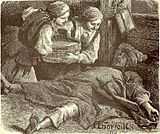Michał Elwiro Andriolli
| Michał Elwiro Andriolli | |
|---|---|
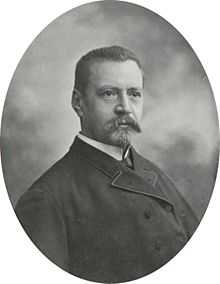 | |
| Born |
2 November 1836 Vilnius |
| Died |
23 August 1893 Nałęczów |
| Known for | painting, drawing |
| Movement | history painting |

Michał Elwiro Andriolli, Lithuanian: Mykolas Elvyras Andriolis, Italian: Elviro Michele Andriolli (2 November 1836, in Vilnius – 23 August 1893, in Nałęczów) was a Polish - Lithuanian[1] painter and architect of Italian descent. He is notable for his illustrations to Mickiewicz's Pan Tadeusz, as well as a distinctive style of villas built outside Warsaw.
Life
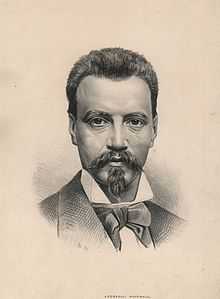
Andriolli was born on 2 November 1836 in Vilna (modern Vilnius) as a son of Francesco Andriolli to a family of an Italian emigrant, a veteran of the Napoleon Bonaparte's Grande Armée. In 1855, he went to Moscow, where he started his studies at the School of Painting and Sculpture. In 1858 he graduated from the Imperial Academy of Art in Petersburg. Andriolli received a scholarship and in 1861 he went to Rome, where he continued his studies at the Accademia di San Luca. He returned to Lithuania and took part in the January Uprising against Russian Empire. Arrested by the tsarist authorities, he managed to escape from Kaunas Prison and reach London and then Paris.
An emissary of the Committee of Polish Emigration, he returned to Russian-held Poland, but was again arrested in 1866. Tried for his part in the Uprising, he was sentenced to katorga in Vyatka. Pardoned in 1871, Andriolli moved to Poland and settled in Warsaw. There he started his career as an illustrator for various newspapers, notably the Tygodnik Ilustrowany, Kłosy and Biesiada Literacka. His work for various Warsaw-based newspapers made him one of the most renown illustration makers of the time and Andriolli was hired to illustrate some of the classic works of the Polish literature, notably the works by Adam Mickiewicz, Juliusz Słowacki and Józef Ignacy Kraszewski. His pictures for the first editions of Mickiewicz's Pan Tadeusz and Konrad Wallenrod, prepared between 1879 and 1882, are regarded as icons of Polish literature even now.
In March 1883, Andriolli visited Paris where he was guest in home of Władysław Mickiewicz the oldest son of Adam Mickiewicz. Between 1883 and 1886, he lived in Paris, where he worked on illustrating the French language editions of works by William Shakespeare and James Fenimore Cooper. Upon his return he also prepared frescoes in several churches, notably in Kaunas.
In the later years of his life, Andriolli found refuge in a small villa he designed for himself near Anielin in what is now the town of Otwock at the Świder River, close to Warsaw. Apart from his own house, he designed several other villas in the area, creating a distinctive architectural style of Warsaw's suburbs. The świdermajer, as it was later dubbed by Konstanty Ildefons Gałczyński, was an eclectic mixture of traditional Mazovian village wooden architecture with Alpine and Siberian styles. It remains a distinctive feature of many of Warsaw's suburbs. Michał Andriolli died on 23 August 1893 in Nałęczów and is buried at the local cemetery.
Works
Michał Andriolli illustrated many books of Polish authors, including:
- Eliza Orzeszkowa novel titled "Meir Ezofowicz",
- Adam Mickiewicz – Pan Tadeusz,
- Józef Ignacy Kraszewski – Stara Baśń in 1879,
- Antoni Malczewski – "Marya" in 1876,[2]
- Władysław Mickiewicz – "Les Récits d'un vieux gentilhomme polonais" 1866,[3]
-
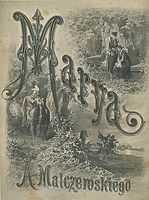
Cover of book Antoni Malczewski from 1876 "Marya".
-
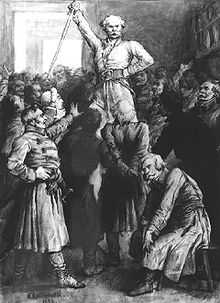
Andriolli's illustration to Pan Tadeusz
-
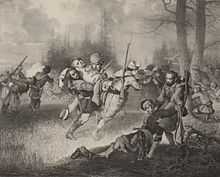
Michał Elwiro Andriolli. Death of Ludwik Narbutt in Dubichi (Russian Empire). National Museum of Lithuania.
Further reading
| Wikimedia Commons has media related to Michał Elwiro Andriolli. |
- Gabriela Socha (1988). Andriolli i rozwój drzeworytu w Polsce (in Polish). Lwów-Wrocław: Ossolineum. p. 277. ISBN 83-04-02685-6.
- Janina Wiercińska (1981). Andriolli; opowieść biograficzna (in Polish). Warsaw: Ludowa Spółdzielnia Wydawnicza. ISBN 83-205-3215-9.
- Michał Elwiro Andriolli. Władysława Jaworska, Janina Wiercińska, ed. Andriolli – świadek swoich czasów; listy i wspomnienia (in Polish). Wrocław-Warsaw: Polish Academy of Sciences, Ossolineum. p. 429.
External links
- Andriolli's illustrations to Pan Tadeusz
- Andriolli's illustrations to Stara Baśń
- http://www.otwock.pl/default.asp?ID=33
- http://www.republika.pl/biblioteka_piotrkow/warsztat/2004/3/040302.htm
Notes and references
- ↑ Sužiedėlis, Saulius (2004). Historical dictionary of Lithuania (2nd ed. ed.). Lanham, Md.: Scarecrow Press. p. 51. ISBN 0810875365.
- ↑ Antoniego Malczewskiego, "Marya. Powieść ukraińska" z 8 ilustracjami E.M. Andriollego. Warszawa 1876. Nakład Gebethnera i Wolffa
- ↑ "Les Récits d'un vieux gentilhomme polonais", Mickiewicz Władysław, Paris 1866.
|
